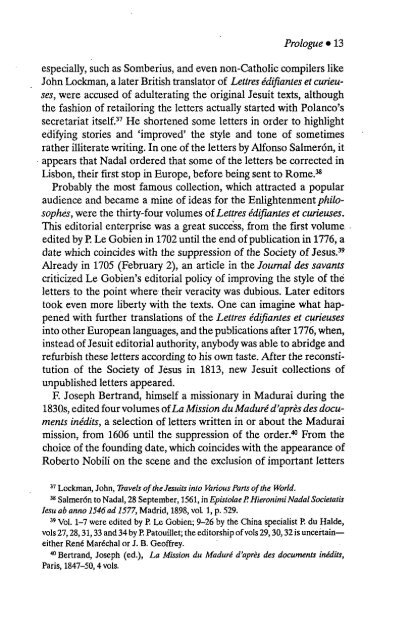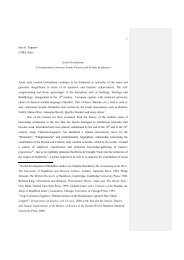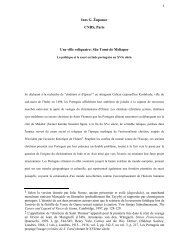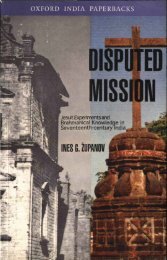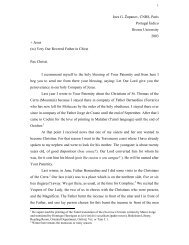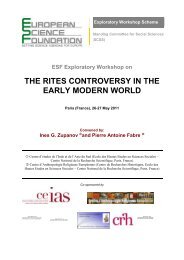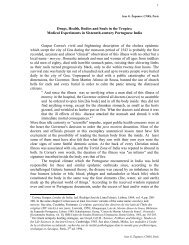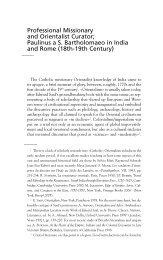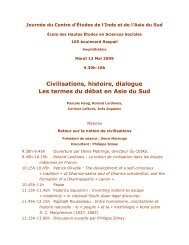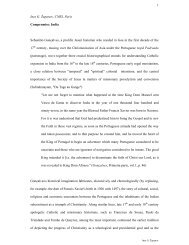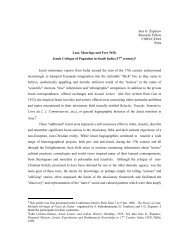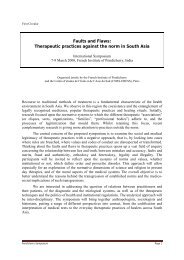INES G. ZUPANOV - Ines G. Županov
INES G. ZUPANOV - Ines G. Županov
INES G. ZUPANOV - Ines G. Županov
Create successful ePaper yourself
Turn your PDF publications into a flip-book with our unique Google optimized e-Paper software.
Prologue • 13<br />
especially, such as Somberius, and even non-Catholic compilers like<br />
John Lockman, a later British translator of Lettres édifiantes et curieuses,<br />
were accused of adulterating the original Jesuit texts, although<br />
the fashion of retailoring the letters actually started with Polanco's<br />
secretariat itself. 37 He shortened some letters in order to highlight<br />
edifying stories and 'improved' the style and tone of sometimes<br />
rather illiterate writing. In one of the letters by Alfonso Salmerón, it<br />
appears that Nadal ordered that some of the letters be corrected in<br />
Lisbon, their first stop in Europe, before being sent to Rome. 38<br />
Probably the most famous collection, which attracted a popular<br />
audience and became a mine of ideas for the Enlightenment philosophes,<br />
were the thirty-four volumes oí Lettres édifiantes et curieuses.<br />
This editorial enterprise was a great success, from the first volume,<br />
edited by P. Le Gobien in 1702 until the end of publication in 1776, a<br />
date which coincides with the suppression of the Society of Jesus. 39<br />
Already in 1705 (February 2), an article in the Journal des savants<br />
criticized Le Gobien's editorial policy of improving the style of the<br />
letters to the point where their veracity was dubious. Later editors<br />
took even more liberty with the texts. One can imagine what happened<br />
with further translations of the Lettres édifiantes et curieuses<br />
into other European languages, and the publications after 1776, when,<br />
instead of Jesuit editorial authority, anybody was able to abridge and<br />
refurbish these letters according to his own taste. After the reconstitution<br />
of the Society of Jésus in 1813, new Jesuit collections of<br />
unpublished letters appeared.<br />
F. Joseph Bertrand, himself a missionary in Madurai during the<br />
1830s, edited four volumes of La Mission du Maduré d'après des documents<br />
inédits, a selection of letters written in or about the Madurai<br />
mission, from 1606 until the suppression of the order. 40 From the<br />
choice of the founding date, which coincides with the appearance of<br />
Roberto Nobili on the scene and the exclusion of important letters<br />
37 Lockman, John, Travels of the Jesuits into Various Parts of the World.<br />
38 Salmerón to Nadal, 28 September, 1561, in Epistolae P. Hieronimi Nadal Societalis<br />
lesu ab anno 1546 ad 1577, Madrid, 1898, voL 1, p. 529.<br />
39 Vol. 1-7 were edited by P. Le Gobien; 9-26 by the China specialist P. du Halde,<br />
vols 27,28,31,33 and 34 by P. Patouillet; the editorship of vols 29,30,32 is uncertain—<br />
either René Maréchal or J. B. Geoffrey.<br />
40 Bertrand, Joseph (ed.), La Mission du Maduré d'après des documents inédits,<br />
Paris, 1847-50,4 vols.


